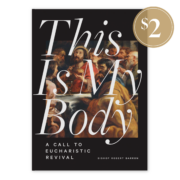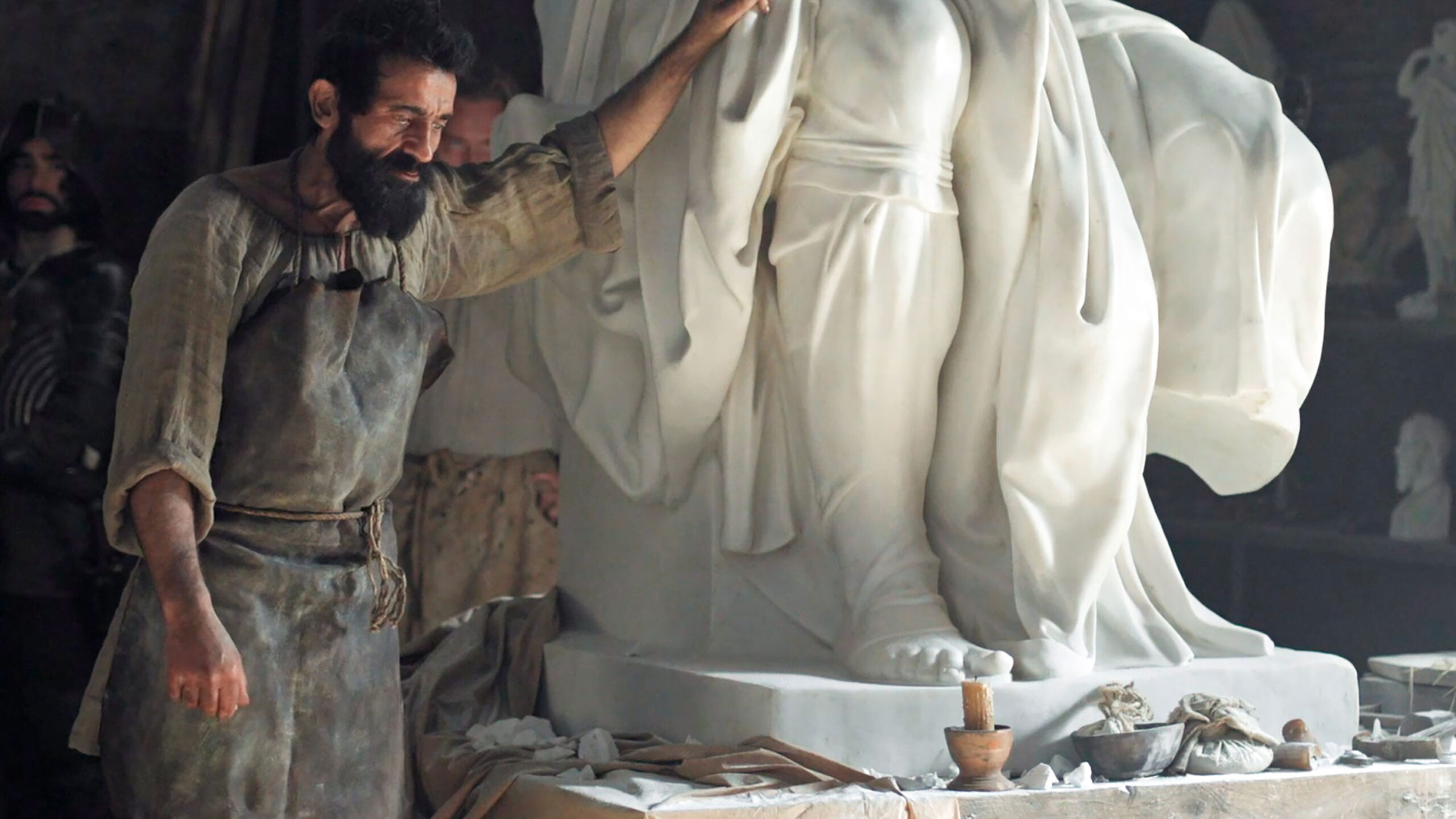In his book The Pivotal Players, Bishop Barron describes the unparalleled and lasting influence of the great Italian master Michelangelo Buonarroti, saying, “Over and against the puritanical, iconoclastic strain . . . Michelangelo proves that the sensual, the artistic, and the beautiful can be a vehicle to the spiritual.” The Russian director Andrei Konchalovsky is on the same page, and his 2019 biopic of Michelangelo, Il Peccato (Sin), demonstrates the complex nature of a genius to whom we all owe so much. Konchalovsky shows how, as with the work of many saints, Michelangelo’s expression of the glory of God in the material realm is the result of mighty struggles within his soul against the forces of darkness. Sin, however, is finally a story of God’s victory not only in paint and marble but in Michelangelo’s heart.
Konchalovsky is a great artistic master himself, having made his first mark on the international film world when he co-wrote the masterpiece Andrei Rublev with Andrei Tarkovksy in 1966. After many films in the Soviet Union, the United States, and back in post-Soviet Russia, Konchalovsky is now doing the best work of his life in his twilight years. His charming 2014 film The Postman’s White Nights was awarded the Silver Lion at the Venice Film Festival. Two years later, his harrowing World War II drama, Paradise, won the same award at the same festival, garnering more widespread international acclaim. His 2020 film Dear Comrades! is a brilliant contrast of human dignity and totalitarian bureaucracy.

Everything Konchalovsky captures on screen these days is of the highest caliber, and of the utmost spiritual significance, and Sin may be his crowning glory. When Vladimir Putin visited Vatican City in 2019, he gave Pope Francis a rough cut of the film, describing how Konchalovsky was one of Russia’s greatest filmmakers, and telling him that the director himself asked especially if the pontiff could arrange to watch it. If he has, it was certainly well worth his time.
He seems to see the whole of reality in every glance, and he experiences pain and frustration as he descends to everyday concerns.
As Sin begins, Michelangelo, played by Alberto Testone (the spitting image of the famous portrait of the master by Daniele da Voltarra) is already regarded as il Divino, the greatest living artist in Italy. We meet the master as he is dealing with family financial troubles in Florence before returning to Rome to finish the Sistine Chapel ceiling in 1512. After four years of labor, Michelangelo is still unhappy with his work, but is eventually made to stop when his inferior contemporary, Raphael, gives his word to the Vatican that the master’s work could not possibly be any better. Like great artists throughout the ages, Michelangelo is a perfectionist, and he must constantly calibrate his vision to that of his wealthy patrons. He seems to see the whole of reality in every glance, and he experiences pain and frustration as he descends to everyday concerns. As power in Rome swings from the Della Rovere family to the Medici, Michelangelo’s own fortunes rise, fall, and rise again as his talent transcends partisan rivalries. If not for his unquestioned superiority above all other artistic contenders, he may have ended up in the gutter, or dead. Likewise, Konchalovsky owes his success under various Russian regimes to his sheer brilliance.
Konchalovsky’s Michelangelo is truly sensual—again, no Puritanism here, thank God—going into trance-like states when he sees a ray of light hit a workman’s veined hand or a veiled woman whose beauty points him to the maternal love of Our Lady. He has passionate but strictly Platonic friendships with his assistants and apprentices, and he finds himself frequently in a position to help family members and friends, even while he laments his own moments of cowardice and betrayal. There are sublime moments of feasting in the film, and scenes when we can almost feel the Tuscan sun above and the rocky trails beneath our feet. The expressiveness of Testone’s face, and particularly his smile, is the sort of thing one only finds four or five times in the history of cinema. But true to life, there are grotesque moments too, especially in shots of the corpulence of Pope Leo X and the grime of Roman back alleys.
He is a man, fully alive; and therefore, he reflects the divine image – a living icon.
Bishop Barron again uses words to describe what Konchalovsky depicts on film, noting that Michelangelo “confirms, more convincingly than any other figure in the Catholic artistic tradition, the great incarnational principle.” He is a man, fully alive; and therefore, he reflects the divine image—a living icon. Moreover, in Michelangelo’s life and work, we see how in a sacramental universe, everything in creation is a potential vehicle for divine presence; and in Sin, we see this vision most of all in Michelangelo’s greatest artistic medium, marble.
A good part of the film focuses on Michelangelo’s trips to and from Carrara as he attempts to get back to work on the long-delayed tomb of Pope Julius II, before he is later pulled into another project and redirected to the Medici quarry at Pietrasanta. In one scene at Carrara, Michelangelo sneaks up into the mountains at night in an almost mystical reverie, accompanied by a copy of his beloved Dante. The next day we meet what we can only call a main character in the film—an enormous, pristine piece of marble nicknamed “Il mostro” (Monster), which claims the life of a quarry worker as a huge team of men attempt to get the rock down the mountain. The man’s death tortures Michelangelo; and yet, we remember that great things come at a high price. There are beautiful shots of Michelangelo prayerfully touching and embracing the stone, endowed with latent power to reveal spiritual truth worth living and dying for.

Time will tell if Konchalovsky, now 84 years old, has created work that our successors will discuss centuries from now, as we continue to revere Michelangelo’s art today. But Sin certainly belongs to a small set of recent films that could bear the weight of being described as a masterpiece. The final scene of Sin, which alludes to Michelangelo’s last great work of his long life, truly warms the heart. And the whole movie inspires us to live passionately, making the most out of our brokenness in pursuit of the all-encompassing, deeply mysterious reality of our Creator. It’s simply the Catholic thing.
Sin is finally the portrait of an extraordinary human—and humanity itself, pursuing its divine destiny. For a film about il Divino, what else could we ask for?
Sin is in Italian with English subtitles, and is now available to rent or purchase on Amazon.
